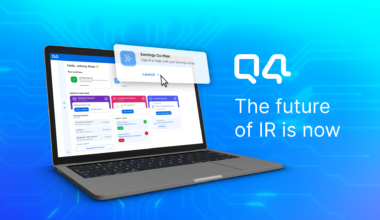The earnings period presents an opportunity to tell your company’s investment story, create interest, and influence your shareholder base. We recently hosted a webinar to ensure you’re prepared to maximize your earnings impact and minimize stress. The webinar, Taking the Stress Out of Earnings Prep, featured Mike Coffey, VP of Global Partnership & Alliances at Q4, John Nunziati, Investor Relations Partner at Q4 and Farah Soi, Partner at ICR. Among the topics discussed, the panel’s top priority was to offer best practices for building trust and confidence across the investment community with an elevated pre-earnings experience.
Where to Start Pre-Earnings
Farrah began by sharing her pre-earnings call preparation checklist as well as tips to make the period less stressful. She explained that her team is strategic and organized in their earnings prep, beginning as soon as they finish the quarter. At this point, they are already mapping out the plan between now and next quarter, even as they’re getting on callbacks with analysts and investors and joining conferences.
As a result, creating a feedback repository to prepare for the upcoming earnings season is a great best practice. She explained that roles and responsibilities must then be divided and delegated, a calendar or checklist can be created, and the work can begin during the pre-earnings period. Not only does it keep you on track, but it holds the FP&A team accountable for delivering data and forecasts on a set timeline.
Timeline and Dates of Pre-Earnings
Along with your timeline, choosing a suitable and strategic date for your company is important. Mike mentioned that here at Q4, we saw a tremendous amount of requests for an earnings date of May 5. He asked the panel how they advise clients to select an earnings date. Finally, he inquired if they preferred to go first or last.
Farrah explained that you could not prepare for earnings in two weeks, and you should choose a date that works best for your company. You may not need extra time if you are an experienced public company with well-established reporting cadences. On the other hand, if you are a new company and this is your first time reporting earnings, you’ll want to view the landscape and gather information and intelligence before you begin. This will provide you with a beneficial forecast for topics, misses, beats, etc.
She explained that it’s helpful to hear other companies articulate the tailwinds and headwinds they experienced in the last earnings season and their magnitude and duration. Finally, she reiterated that it falls on the IR team to report back to the FP&A team with that data, providing a forecast for the company and questioning whether a wider margin of safety is required because a broader uncertainty creates a more comprehensive range of outcomes.
Farrah used the last pre-earnings period to exemplify that we’re at a point of uncertainty due to process issues brought on by inflationary and supply chain pressures. She explained that during COVID-19, we were in an environment where aggressive guides went unrewarded, and in fact, we saw and read about aggressive guides getting sold off, resulting in a bottom-up process. She declared that she wouldn’t want to go first or last and would prefer to go with background knowledge and intelligence about the current landscape if possible.
Nunziati chimed in, saying that unless this is your first earnings call, you tend to be driven by the availability of your results. Specifically, he references this year’s most popular date of May 5, which is likely a top choice because it is essentially five weeks after the end of the quarter. He explained that companies close their books, build their analysis, and prepare their messaging in those 5 intervening weeks before the earnings call. While organizations want to be able to report as soon as possible, dates are often driven by an organization’s preparation timeline.
Further, he warned that if you end up presenting first among your peer group or industry, you will need to rely on other sources in anticipation of possible discussion topics. These may include subjects of interest in investor conferences, questions that were asked in investor meetings, or even soliciting subjects of importance from your sell-side in advance–everyone has a unique approach.
He explained that the key is to ensure a good understanding of the anticipated topics and plan how you intend to address them. He also advised that it’s essential to determine if something is a topic you’re going to provide a prepared comment during pre-earnings on in your remarks or if it’s a topic you want to cover in your Q&A.
Process & Pre-Recording During Pre-Earnings
As the discussion shifted toward the earnings process, Mike noted that the evolution of earnings and the ever-increasing importance of technology is primarily due to the COVID-19 pandemic. He mentioned that we saw an increase of companies pre-recording their earnings over the last few years and questioned John’s thoughts on this technique as well as how he thinks hosts’ stress levels have been affected.
John explained that he has been a big fan of pre-recordings and considers himself an early adopter of this process. He said that figures show that at least 25% of earnings are pre-recorded. However, he estimates it is actually much more significant–and still growing–because remote teams have made some of the inherent benefits of pre-recording more apparent.
John explained his theory that there are two substantial benefits of pre-recording; time management and having the space to focus on your Q&A segment. Both of which will ensure preparedness and confidence. He also suggested that if you choose to pre-record, you need to ensure you finish editing at least 24-hours in advance to avoid a stressful time crunch.
He also reminded the audience that it is okay to switch to live if any data unexpectedly changes or other shifts occur; it’s crucial to have a contingency plan. Luckily, you will already have your script and practice Q&A in place. Farrah agreed, reminding everyone that there is no need to stress out or worry about a change of plans when you have a plan B.
The Earnings VIP: Q&A
When talking about the components and process of earnings calls, Mike asked Farrah where she finds the most value, whether it’s the information shared before the Q&A or the Q&A itself. She replied that she doesn’t think one is more important than the other, considering some of the questions you may have received in Q&A will be answered by the information presented beforehand.
But, she explained that the Q&A session is critical, and that’s why she schedules enough time for that segment. She explained that she tells her clients that she has failed them if a question comes up that they were not prepared for. She also advises teams to be prepared to answer questions that they might not want to–that a short answer in good faith is better than no response.
John suggested having a document prepared with key messaging that captures the topics you expect to be surfaced in Q&A–and ideally, how you’re going to respond to them. Mike offers a tip that he received on LinkedIn, to create a document with all of the possible questions that the team could be asked, to ensure that they prepare for every question that may arise.
Competitive Landscape
As the panel discussed the competitive landscape and the amount of analysis of the clients’ peer calls that go into prep work, Farrah explained that the process consists of two significant steps: Research and gathering information and transforming the data into digestible pieces. These pieces become cheat sheets and summary snapshots of critical topics and data that can help prepare for earnings. Farrah summed this up by saying that what other companies are reporting on can impact the metrics you’re delivering and your messaging tone. Further, she said they need to package all of this to deliver it to the street in the form of earnings.
The Future of IR Earnings Calls
As the world drastically shifted from in-person to virtual over the past few years (and back again, in some cases), virtual IR events have become a welcome change on the street. When asked if he sees video earnings as the future of IR earnings calls, John commented that he considers it to be an emerging best practice that is not yet fully adopted.
He believes that video earnings strengthen the relationship between companies’ management teams and the investor community. The continued benefits of seeing management’s delivery and response to questions, even when the decision is made to go virtual, are substantial. Additionally, this practice affords IR teams a library of material, always expanding as you accumulate more content, and providing the opportunity be shortened and used as media on your website. This also gives shareholders the ability to refer people back to specific moments in the replays when necessary.
Farrah agreed, adding that people feel they gain more tangible information from video earnings calls, plus they feel much more of a personable connection seeing management and interacting with them. She said the feedback has been great because they feel like it’s closer to an in-person meeting than a phone call.
To learn more, watch the recording here.


